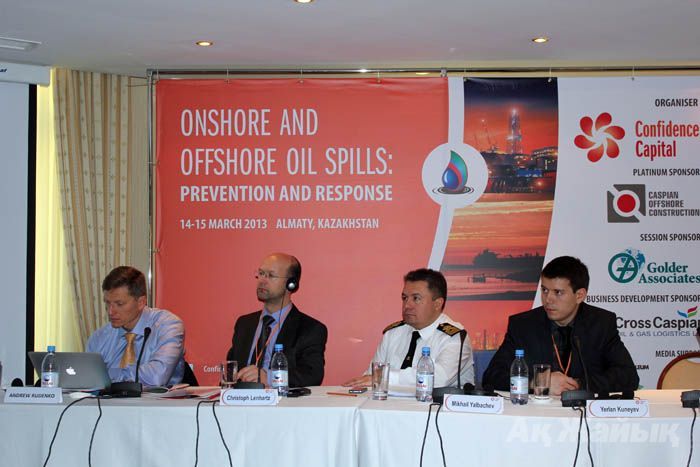By Laura SULEIMENOVA
 March 14-15, Almaty hosted the international conference “Industrial Safety in Fuel and Energy Complex. Onshore and Offshore Oil Spills”. The key topic was the start of oil production at the field of Kashagan scheduled for June.
March 14-15, Almaty hosted the international conference “Industrial Safety in Fuel and Energy Complex. Onshore and Offshore Oil Spills”. The key topic was the start of oil production at the field of Kashagan scheduled for June.
Need plan. Not declaration.
What happened at the conference surprised me – an event with a “technological” title virtually became a platform for the ones doubtful of the environmental safety of forthcoming crude production in the NE Caspian Sea.
Optimistic assurances were voiced too, for example, by Sergei Ulzhabayev, deputy head of emergency of Mangystau, in a work-is-being-done, exercises-in-place, we-have-national-oil-spill-response-plan manner and so on.
However, his opponents were more convincing.
Galina Artyukhina, acting director of Kazakh Association of Nature Users for Sustained Development, said the national onshore and offshore oil spill response plan adopted in 2012, of which regional version has not been adopted yet, bears a declarative manner, instead of actions to prevent oil spills in the Caspian Sea.
Environmental ministry seems to understand this, as minister Kapparov numerously claimed our side was not ready. Nevertheless, production at Kashagan will start this summer.
Be prepared for the worst scenario
According to Artyukhina, lack of summarized information may hamper quick spill response. Although operators are long monitoring background of Caspian, no scientifically grounded publication was issued on the point. No common database between oil companies, research centers and environmental contractors is in place. Experts and scientists are bound before operators not to disclose “confidential” information.
“In case of emergency, none of the sides will undertake responsibility of decision making, as they, virtually, have no idea what the result of their action will be” says Artyukhina insisting on the idea to develop a new plan based on the experience of countries with conditions similar to the north-east of the Caspian Sea.
Ulzhabayev and his colleagues seemingly disliked Artyukhina’s report, trying to contest her statements.
To my mind came the conclusion by the special commission of the US government for the Deepwater Horizon accident in the Gulf of Mexico, which stated the main reason of the catastrophe was poor arrangement of work and poor coordination between BP and contractors.
“Our government allowed this to happen” then said a commission member.
Legends already exist about disputes between the Kashagan operators.
A guest from Norway, Asbjorn Klaussen, urged to always be ready for the worst scenario when extracting oil in the sea, keeping in mind the 1977 Ekofisk accident in his country.
As a result of an explosion at the drilling rig of Ekofisk, oil gushed for 8 days spilling over 200,000 barrels of crude into North Sea.
“To our government that was a shock. Afterwards, the Norwegian laws were reconsidered to make us prepared for such accidents. We understood how important is to have the best equipment and well-trained personnel,” the Norwegian said.
Russian view from space
Reps of Russia’s oil companies and emergency ministry and Azerbaijan’s state-owned oil company also attended the event.
As it turned out, like us, Azerbaijani national oil spill response plan still was in approval phase.
On the sidelines, Kazakh and Russian oilmen said the situation in drilling waste utilization in Azerbaijan is even worse.
Russians [Lukoil-Nizhnevolzhskokamsk] successfully conduct environmental monitoring of both their own sector of the sea and the neighboring Kazakh area and regularly detect contamination by vessels that intentionally get rid of oil containing wastes.
Also, space satellites discovered active seepages in Kazakh sector – channels of uncontrolled oil and gas discharge.
In particular, a group of stains in the form of thin curves of a 50-150 meter width and 0.3-3km long were noticed near Tub-Karagan Peninsula in Mangystau Oblast. Very likely, these are the traces of drowned oil wells, of which number is still unknown.
Hero of the occasion
All invitees took an active part in the conference, except “the hero of the occasion” – NCOC developing Kashagan. Listed among the guests, Agip KCO Oil Spill Response Coordinator Mark Sheppard, who once claimed it easy to collect oil from the Caspian surface in winters, failed to turn up. He would learn a lesson, if he was in Almaty that day and listened to the speakers talking about challenges of spill response in winter given shallow depth conditions and high H2S content in Kashagan oil.
According to Pilegaard Jenssen, the vice-president of Denmark’s DESMI, a company specializing in oil spill response hardware, only a few companies in the world develop equipment and provide maintenance for big projects in need for measures to collect oil in low temperatures.
The skimmer he presented took 3 years to design. Transnational companies involved in Kashagan funded its development. Remotely controlled it sucks oil from a 6m radius sea area surrounded with slick bars. One piece of such a skimmer costs over 200,000 euros.
Interesting, but these skimmers were not bought for Kashagan project. Instead, they have 200 meters of special slick bars that may endure heat of up to 600°C.
“Clear that NCOC and Agip do not preclude the risk of spills and further ignition of oil knowing its high H2S content,” said a guest.
- So, is it easier to collect spilled oil in winter? I asked Jenssen.
- No, much more difficult, he replied.
 В Атырау 0
В Атырау 0